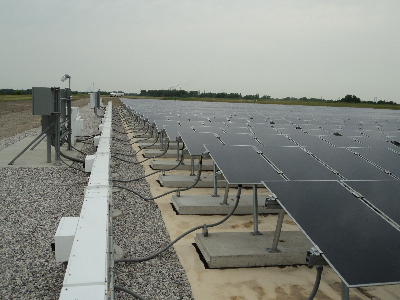 |
During the past couple years, many engineers, contractors and other construction and regulation professionals have read about the interaction between thin-film photovoltaic cells and exposed geomembrane caps on closed waste cells. American Environmental Group Ltd. (AEG) has been proud to be part of these unique new designs in waste management; but they are certainly not the only solar energy-generating designs in which geosynthetics are being used.
Geomembranes are also being used to provide essential containment and soil/groundwater protection for sites that utilize rigid solar panels, such as arrays installed on brownfield sites.
In Northwood, Ohio, the flat glass producer Pilkington North America has unveiled a 3,200+ panel array of rigid solar panels capable of producing roughly 250 kw, which is equivalent to almost 12% of the company’s research-department power needs. The installation, located adjacent to the company’s facility, includes a base liner manufactured by Firestone and that has been installed by AEG’s Geosynthetics Division (an IAGI Approved Installation Contractor). The geomembrane is a TPO product, chosen largely for its durability characteristics and excellent dimensional stability, limiting expansion and contraction.
Excellent communication and cooperation between all involved parties (Pilkington, AEG, Firestone, and designer Hull & Assoicates) has ensured productive, accident-free, quality work.
Though a fairly small installation, the site is significant in that it is the largest solar array installed by a private company for its own use in Ohio. Considering the increased availability of state environmental grants, recent EPA initiatives for brownfield development, and green engineering tax credits, and with solar energy design becoming ever more affordable, efficient and powerful, more installations of this nature are anticipated.
For more information on AEG’s Geosynthetics Division, visit www.aegl.net.
Have a project story for Geosynthetica? Contact the editor, Chris Kelsey at chris@geosynthetica.net.











